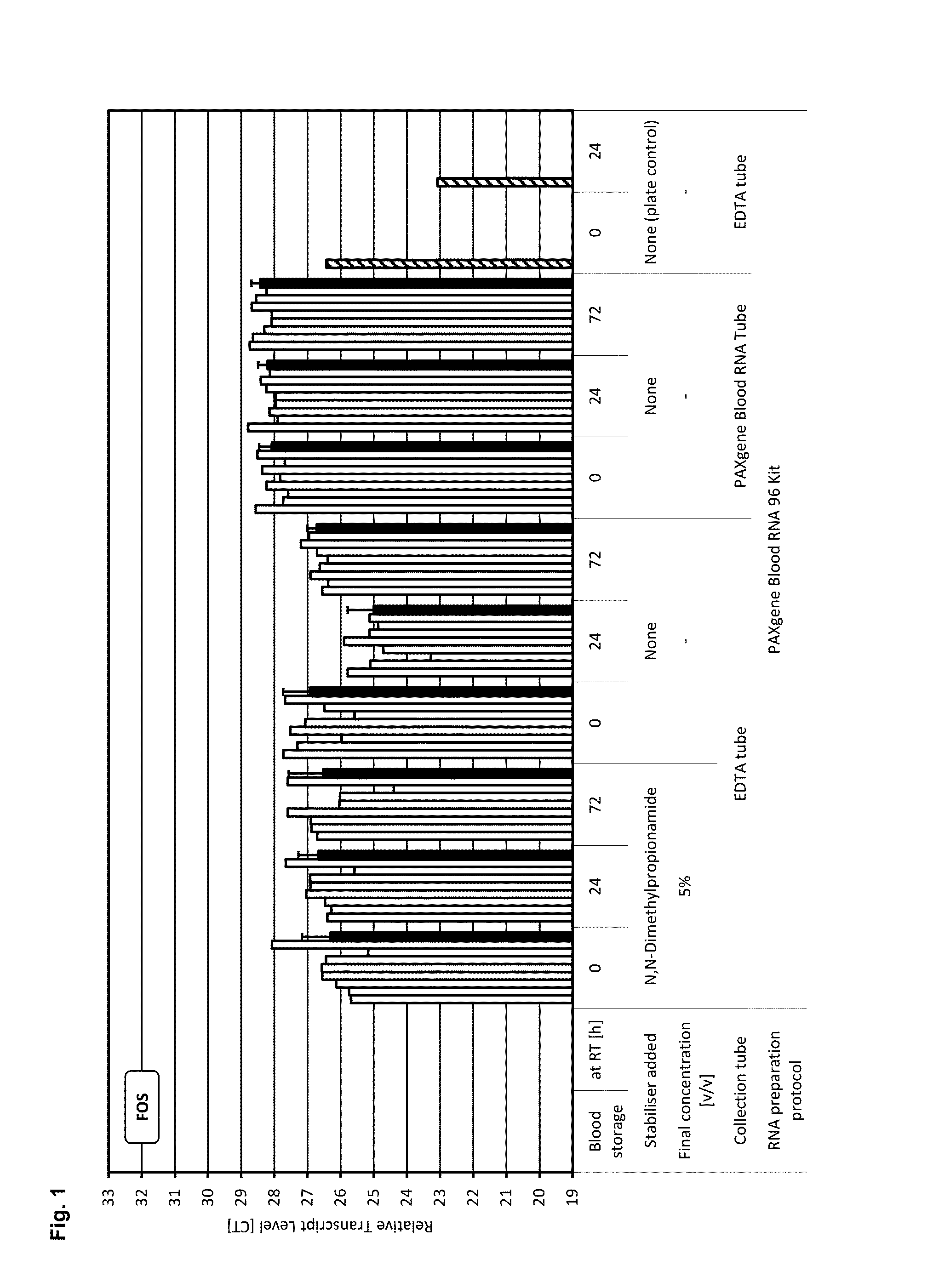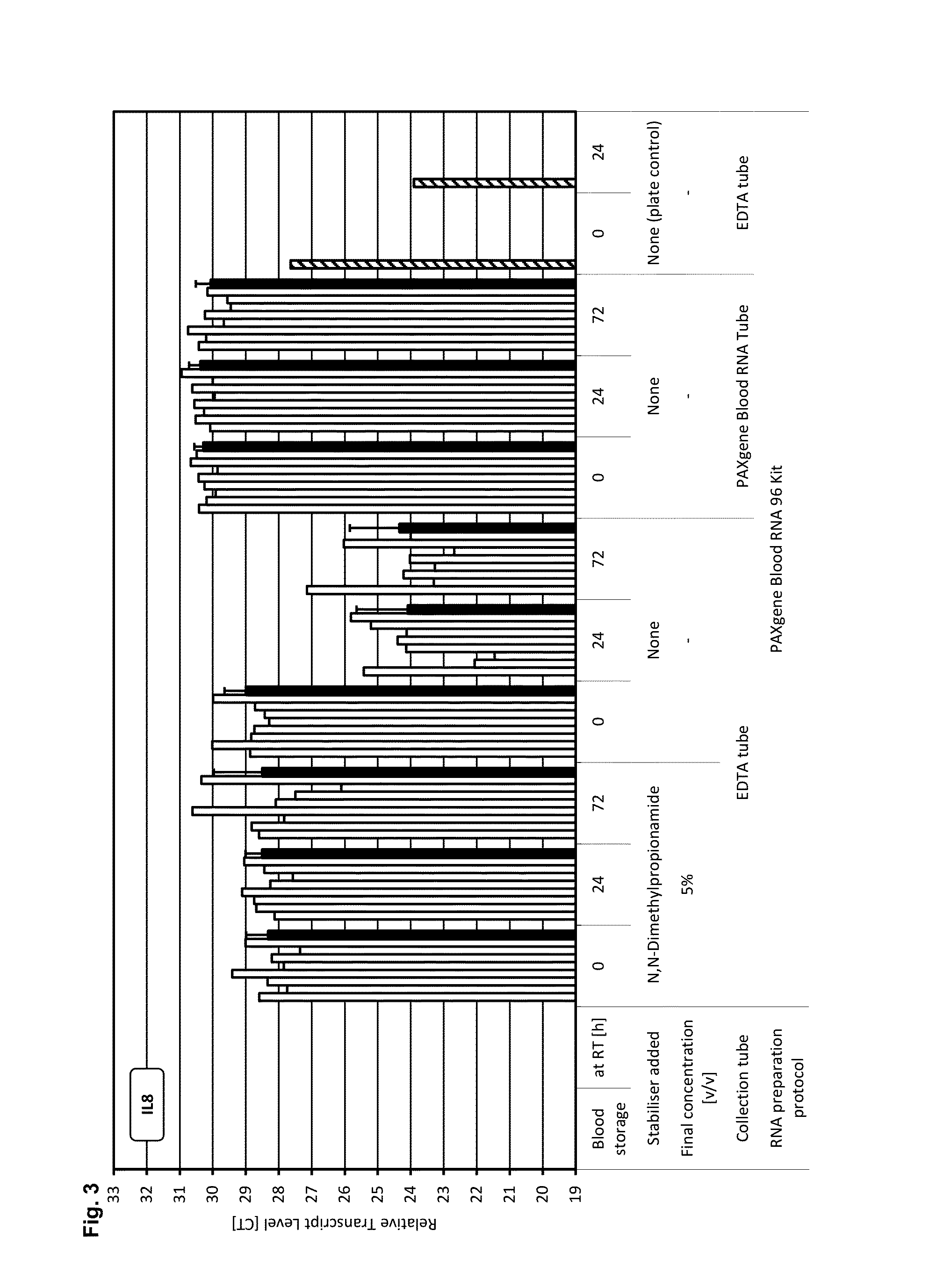Stabilisation of biological samples
a biological sample and stabilization technology, applied in the field of biological sample stabilisation, can solve the problems of affecting affecting the subsequent analysis, and severely altering the expression profile of the targeted molecules, so as to reduce variability, improve the quality of the sample, and stabilize the gene transcription profile of contained cells.
- Summary
- Abstract
- Description
- Claims
- Application Information
AI Technical Summary
Benefits of technology
Problems solved by technology
Method used
Image
Examples
example 1
Use of N,N-Dimethylpropanamide for Stabilizing Blood Samples
[0200]A test system and study setup was established that allows the identification of reagent compositions that have gene transcript stabilisation capabilities, as indicated by constant levels of transcripts from selected genes (c-fos, IL-1beta, IL-8, p53). These transcripts were identified in prior studies as very unstable transcripts during storage, which are induced or down regulated (gains and losses of transcripts) within minutes after blood collection and were therefore chosen as “worst case” markers for screening purposes.
[0201]Moreover to exclude any possible influence of the RNA preparation protocol on the analysis of transcript levels, the same RNA preparation technology used for the [+] control of sample stabilisation was also used for [−] control of samples stabilisation and for test samples.
[0202]Blood was collected from multiple donors into replicate EDTA blood tubes (BD, [−] control of sample stabilisation) a...
example 2
Stabilization Using N,N Dimethylpropanamide without Caspase Inhibitor
[0220]In example 2, different concentrations of N,N dimethylpropanamide (DMPA) were used for stabilizing blood samples obtained from different donors. The focus of the analysis was the stabilization of the extracellular nucleic acid population as determined by analyzing the increase of 18S rDNA. Stabilization and processing of the samples were performed as described in materials and methods under II.
[0221]The stabilization solutions without caspase inhibitor comprised N,N dimethylpropanamide in different concentrations and EDTA. When adding these stabilization solutions to the blood sample, the following final concentrations were obtained in the blood / stabilization solution mixture: 7.2 mg K2 EDTA / ml and different concentrations of N,N dimethylpropanamide (1.5%, 2% or 2.5%). DMAA stabilized samples (5%) were also included as reference.
[0222]FIGS. 6 and 7 show the stabilization results obtained when blood was stabil...
example 3
Stabilization with N,N Dimethylpropanamide and Caspase Inhibitor
[0223]Blood from two different donors was collected into 10 ml K2 EDTA tubes (BD). 4.5 ml of the respectively collected blood was mixed with 0.9 ml stabilization solution comprising N,N dimethylpropanamide, EDTA and a caspase inhibitor. Thereby, the following final concentration in the blood / stabilization mixture was obtained which is as follows:
[0224]7.2 mg K2 EDTA, 1 μM Quinoline-Val-Asp-CH2-OPH (caspase inhibitor) and 2.5%, 5% or 7.5% (v / v) N,N dimetylpropanamide or 5% (v / v) DMAA, respectively.
[0225]All stabilized blood samples were set up in triplicates per condition and test time point. At time point 0 (reference), immediately after mixing the stabilization solution and blood, plasma was generated and the ccfDNA was extracted. The residual blood sample was stored for three days and six days at room temperature. As a control, the EDTA stabilized blood sample was also stored for 3 and 6 days. The plasma was generated...
PUM
| Property | Measurement | Unit |
|---|---|---|
| time | aaaaa | aaaaa |
| time | aaaaa | aaaaa |
| time | aaaaa | aaaaa |
Abstract
Description
Claims
Application Information
 Login to View More
Login to View More - R&D
- Intellectual Property
- Life Sciences
- Materials
- Tech Scout
- Unparalleled Data Quality
- Higher Quality Content
- 60% Fewer Hallucinations
Browse by: Latest US Patents, China's latest patents, Technical Efficacy Thesaurus, Application Domain, Technology Topic, Popular Technical Reports.
© 2025 PatSnap. All rights reserved.Legal|Privacy policy|Modern Slavery Act Transparency Statement|Sitemap|About US| Contact US: help@patsnap.com



